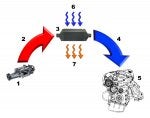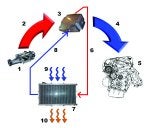This is a work in progress... please be patient while it is fleshed out. There will be plenty of time later for input and discussion. Instead of this being a thermodynamics treatise, I'd like it to be a basic level introduction to heat transfer. There are lots of highly educated and/or experienced people here... differential equations are fun party conversation, but let's start with the basics here.
FULL DISCLOSURE: I'm an engineer, but I'm also a business owner. That business sells intercoolers, so please realize that there is bound to be some degree of bias on my part. While I will strive to be objective, understand that I favor one solution over another. Think for yourself.
Heat always "flows" from hot --> cold. More specifically, from the higher temperature material to the cooler temperature material.
Heat can flow in several ways: (for our purposes, these three types are the most relevant): through conduction (direct contact is required), through radiation (it is how heat gets to the Earth from the sun through the vacuum of space), through convection (requires air or other fluid movement).
Different materials allow heat to "flow" faster or slower, this is referred to as the "thermal conductivity" of a material. Heat flows through aluminum much faster than heat flows through water, wood or ceramics.
Different materials also have different capacities to absorb / hold heat, this is call a substance's "heat capacity." A 1 lb block of iron will hold a lot more heat than a 1 lb block of foam. 1 lb of water can hold about four times as much heat as 1 lb of aluminum (more on this later... it gives an A2W a short term advantage over an A2A intercooler).
... to be continued ...
Common Intercooler Types
A2A
- tube and fin: generally lighter, less expensive to manufacture, but lower thermal mass.
- bar and plate: generally more expensive, higher thermal mass.
A2W
- absorbs heat at the A2W intercooler, transfers the heat to water, water is pumped to a remote radiator.
Which intercooler is better? That depends... see discussions below. An A2A isn't always better than an A2W. A bar and plate intercooler isn't always better than a tube & fin. It depends... Read on.
FULL DISCLOSURE: I'm an engineer, but I'm also a business owner. That business sells intercoolers, so please realize that there is bound to be some degree of bias on my part. While I will strive to be objective, understand that I favor one solution over another. Think for yourself.
Heat always "flows" from hot --> cold. More specifically, from the higher temperature material to the cooler temperature material.
Heat can flow in several ways: (for our purposes, these three types are the most relevant): through conduction (direct contact is required), through radiation (it is how heat gets to the Earth from the sun through the vacuum of space), through convection (requires air or other fluid movement).
Different materials allow heat to "flow" faster or slower, this is referred to as the "thermal conductivity" of a material. Heat flows through aluminum much faster than heat flows through water, wood or ceramics.
Different materials also have different capacities to absorb / hold heat, this is call a substance's "heat capacity." A 1 lb block of iron will hold a lot more heat than a 1 lb block of foam. 1 lb of water can hold about four times as much heat as 1 lb of aluminum (more on this later... it gives an A2W a short term advantage over an A2A intercooler).
... to be continued ...
Common Intercooler Types
A2A
- tube and fin: generally lighter, less expensive to manufacture, but lower thermal mass.
- bar and plate: generally more expensive, higher thermal mass.
A2W
- absorbs heat at the A2W intercooler, transfers the heat to water, water is pumped to a remote radiator.
Which intercooler is better? That depends... see discussions below. An A2A isn't always better than an A2W. A bar and plate intercooler isn't always better than a tube & fin. It depends... Read on.









